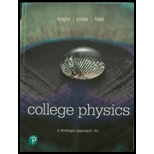
Concept explainers
Four lightweight balls A, B, C, and D are suspended by threads. Ball A has been touched by a plastic rod that was rubbed with wool. When the balls are brought close together, without touching, the following observations are made:
- Balls B, C, and D are attracted to ball A.
- Balls B and D have no effect on each other.
- Ball B is attracted to ball C.
What are the charge states (positive, negative, or neutral) of balls A, B, C, and D? Explain.
To explain: The charge states of balls A, B, C and D.
Answer to Problem 1CQ
The charge states of balls A, B, C and D are negative, neutral, positive, and neutral respectively.
Explanation of Solution
The plastic rod acquires a negative charge, when it is rubbed by wool. Initially, when the rod touches the ball A, it gets polarized and acquires a negative charge. Hence, the charge on ball A is negative.
Balls B, C, and D are attached to ball A:
Balls B, C, and D are attached to ball A due to the attraction force because unlike charges attract. This is possible only if charges on balls B, C, and D are either positive or neutral.
Balls B and D have no effect on each other:
This statement indicates that the balls B and D neither attracted nor repulsed with each other. The like charges repel and unlike charges attract. Therefore, balls B and C posses no charge either positive or negative. Hence, balls B and D are neutral.
Ball B is attracted to ball C:
This statements concludes that the ball C is charged and that is the reason the neutral ball B is attracted towards C. From first statement, it is obvious that the charge of ball C must be either positive or neutral. Ball C is not neutral and hence the charge on ball C is positive.
Conclusion:
Thus, the charge states of balls A, B, C and D are negative, neutral, positive, and neutral respectively.
Want to see more full solutions like this?
Chapter 20 Solutions
College Physics: A Strategic Approach (4th Edition)
Additional Science Textbook Solutions
Human Anatomy & Physiology (2nd Edition)
Chemistry: The Central Science (14th Edition)
Organic Chemistry (8th Edition)
Genetic Analysis: An Integrated Approach (3rd Edition)
Campbell Essential Biology with Physiology (5th Edition)
Microbiology with Diseases by Body System (5th Edition)
- Hi! I need help with these calculations for part i and part k for a physics Diffraction Lab. We used a slit width 0.4 mm to measure our pattern.arrow_forwardExamine the data and % error values in Data Table 3 where the angular displacement of the simple pendulum decreased but the mass of the pendulum bob and the length of the pendulum remained constant. Describe whether or not your data shows that the period of the pendulum depends on the angular displacement of the pendulum bob, to within a reasonable percent error.arrow_forwardIn addition to the anyalysis of the graph, show mathematically that the slope of that line is 2π/√g . Using the slope of your line calculate the value of g and compare it to 9.8.arrow_forward
- An object is placed 24.1 cm to the left of a diverging lens (f = -6.51 cm). A concave mirror (f= 14.8 cm) is placed 30.2 cm to the right of the lens to form an image of the first image formed by the lens. Find the final image distance, measured relative to the mirror. (b) Is the final image real or virtual? (c) Is the final image upright or inverted with respect to the original object?arrow_forwardConcept Simulation 26.4 provides the option of exploring the ray diagram that applies to this problem. The distance between an object and its image formed by a diverging lens is 5.90 cm. The focal length of the lens is -2.60 cm. Find (a) the image distance and (b) the object distance.arrow_forwardPls help ASAParrow_forward
 Physics for Scientists and Engineers with Modern ...PhysicsISBN:9781337553292Author:Raymond A. Serway, John W. JewettPublisher:Cengage Learning
Physics for Scientists and Engineers with Modern ...PhysicsISBN:9781337553292Author:Raymond A. Serway, John W. JewettPublisher:Cengage Learning Physics for Scientists and Engineers: Foundations...PhysicsISBN:9781133939146Author:Katz, Debora M.Publisher:Cengage Learning
Physics for Scientists and Engineers: Foundations...PhysicsISBN:9781133939146Author:Katz, Debora M.Publisher:Cengage Learning Principles of Physics: A Calculus-Based TextPhysicsISBN:9781133104261Author:Raymond A. Serway, John W. JewettPublisher:Cengage Learning
Principles of Physics: A Calculus-Based TextPhysicsISBN:9781133104261Author:Raymond A. Serway, John W. JewettPublisher:Cengage Learning Physics for Scientists and Engineers, Technology ...PhysicsISBN:9781305116399Author:Raymond A. Serway, John W. JewettPublisher:Cengage Learning
Physics for Scientists and Engineers, Technology ...PhysicsISBN:9781305116399Author:Raymond A. Serway, John W. JewettPublisher:Cengage Learning Physics for Scientists and EngineersPhysicsISBN:9781337553278Author:Raymond A. Serway, John W. JewettPublisher:Cengage Learning
Physics for Scientists and EngineersPhysicsISBN:9781337553278Author:Raymond A. Serway, John W. JewettPublisher:Cengage Learning College PhysicsPhysicsISBN:9781305952300Author:Raymond A. Serway, Chris VuillePublisher:Cengage Learning
College PhysicsPhysicsISBN:9781305952300Author:Raymond A. Serway, Chris VuillePublisher:Cengage Learning





